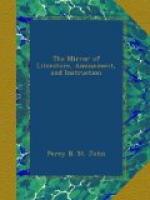“Which now lies naked to the injuries
Of stormy weather.”
Not far from this Elysium is the seat of Lord Feversham, (late Charles S. Duncombe, Esq.) the owner of the estate, called Duncombe Park, where is a piece of fine sculpture, called the Dog of Alcibiades, said to be the work of Myron, and ranked among the five dogs of antiquity. Here is also the famous Discobolus, which is esteemed the first statue in England. Among the splendid collection of paintings is a candle-light scene (woman and child) by Rubens, which cost 1,500 guineas. The mansion was designed by Sir J. Vanbrugh. Leaving this bewitching retreat, we proceeded down the sides of the woody mount; and after some tedious inquiries respecting our road through this wild region, we were directed to take a path through a sloping wood; but useless are all attempts to describe our route through this wilderness. Sometimes our weary feet were relieved from the rough stones and briars by an intervening lawn; and at others we were entirely shrouded from “day’s garish eye” by entwining trees. Our rugged pilgrimage was rendered more endurable by the anticipation of shortly seeing Byland abbey; but still my romantic spirit was loitering in the pillared aisles of Rievaulx. By and by we quitted the wood, and having descended a deep ravine, we climbed a barren moor, over which we had proceeded half way, when to my unutterable joy, we discovered the far-off fane of Rievaulx, whose wan towers just peered from out of the hanging woods. Pursuing our way we soon exchanged the trackless moor for a much more grateful domain. A sloping wood on each side of us opened into a wider expanse, and the turrets of Byland abbey appeared in the distance. At this moment we forgot the toil of threading harassing woods and crossing wide heaths. After refreshing ourselves we proceeded to view the ruin.
Byland abbey was founded in 1177, by the famous Roger de Mowbray, who amply endowed it, and was buried here. He retired hither after being perplexed and fatigued with useless crusades, and suffering the deprivation of nearly all his property by Henry II. Martin Stapylton, Esq. the present proprietor of Byland, discovered from some ancient manuscripts the precise situation in the ruin, where were deposited the bones of the illustrious chieftain; and after removing these relics of mortality which had been hid for six hundred years, he conveyed them in his carriage to Myton, and interred them in the church-yard. The abbey of Byland is memorable for having given concealment, (though not a sanctuary!) to Edward II. who, when flying from his enemies in the north, in 1322, took shelter here, and was surprised by them when at dinner, narrowly escaping, by the swiftness of his horse, to York; and leaving his money, plate, and privy seal, a booty to the savage and exterminating Scots. Byland abbey has nearly disappeared; the only perfect remains are the west end, a fine specimen of Saxon




